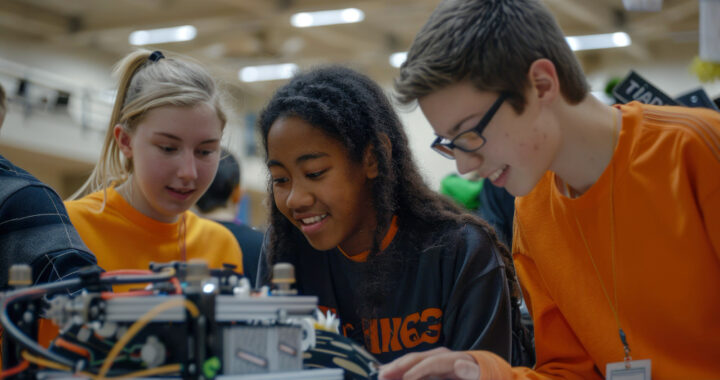How to Incorporate Collaborative Features in Social Learning Platforms

Social learning is a process where individuals learn from observing and interacting with others. It emphasizes the importance of social interactions and collaborative efforts in the learning process. With the rise of digital platforms, social learning has gained prominence as an effective way to enhance education, workplace training, and community engagement.
In today’s interconnected world, understanding the importance of social learning and incorporating collaborative features into various platforms can significantly improve the learning experience. This article delves into the fundamentals of social learning, its benefits, applications, and practical ways to incorporate collaborative features into learning platforms.
Theoretical Foundations of Social Learning
Albert Bandura’s Social Learning Theory
Albert Bandura’s Social Learning Theory posits that people learn from one another through observation, imitation, and modeling. This theory highlights the role of cognitive processes in social interactions and suggests that learning occurs in a social context.
Vygotsky’s Social Development Theory
Lev Vygotsky’s Social Development Theory emphasizes the fundamental role of social interaction in cognitive development. According to Vygotsky, community and collaboration are critical components of the learning process, and higher cognitive functions develop through social interactions.
Collaborative Learning Theories
Collaborative learning theories focus on the benefits of group work and peer-to-peer interaction. These theories advocate for shared goals, mutual support, and collective problem-solving as essential elements of effective learning.
Benefits of Social Learning
Enhanced Knowledge Retention
Learning in a social context helps individuals retain information better. Discussions, group activities, and collaborative projects reinforce knowledge and improve long-term retention.
Improved Critical Thinking Skills
Social learning encourages critical thinking and problem-solving skills. Engaging with diverse perspectives and debating different viewpoints fosters deeper understanding and analytical abilities.
Increased Engagement and Motivation
Collaborative learning environments are more engaging and motivating. The sense of community and shared objectives keeps learners interested and committed to the learning process.
Development of Social and Communication Skills
Interacting with peers enhances social and communication skills. Learners develop the ability to articulate ideas, listen actively, and work effectively in teams.
Applications of Social Learning in Different Settings
Social Learning in Education
Classroom Environments
In traditional classroom settings, social learning can be facilitated through group discussions, peer tutoring, and collaborative projects. These activities promote active participation and deeper understanding of the subject matter.
Online Learning Platforms
Digital platforms offer numerous opportunities for social learning. Features like discussion forums, video conferencing, and collaborative documents enable learners to engage with peers and instructors in real-time.
Role of an eLearning App Development Company
An elearning app development company plays a crucial role in designing and implementing effective online learning platforms. These companies specialize in integrating collaborative features that enhance user engagement and learning outcomes.
Social Learning in the Workplace
Corporate Training Programs
Businesses are increasingly adopting social learning strategies in their training programs. Interactive workshops, team-based projects, and mentorship programs enhance employee learning and development.
Peer-to-Peer Learning
Peer-to-peer learning initiatives allow employees to share knowledge and skills with each other. This approach fosters a culture of continuous learning and collaboration within the organization.
Social Learning in Social Media
Influencer Marketing
Social media platforms are powerful tools for social learning. Influencers share knowledge and experiences with their followers, creating learning opportunities through content and interactions.
Online Communities
Online communities and forums provide spaces for individuals to share ideas, ask questions, and learn from each other. These platforms facilitate continuous learning and networking.
Collaborative Features in Social Learning Platforms
Discussion Forums
Discussion forums enable learners to post questions, share insights, and engage in meaningful conversations. These forums create a sense of community and support collaborative learning.
Real-Time Chat
Real-time chat features allow instant communication between learners and instructors. This immediate interaction enhances engagement and facilitates quick problem-solving.
Collaborative Projects and Assignments
Collaborative projects and assignments encourage teamwork and collective problem-solving. These activities help learners apply theoretical knowledge to practical scenarios.
Peer Review and Feedback
Peer review and feedback mechanisms promote constructive criticism and self-reflection. Learners benefit from diverse perspectives and improve their work based on peer suggestions.
Social Media Integration
Integrating social media features into learning platforms enables learners to share their achievements, connect with peers, and access a wider range of resources.
Gamification Elements
Gamification elements like badges, leaderboards, and rewards motivate learners and make the learning experience more enjoyable and competitive.
How to Incorporate Collaborative Features in Social Learning Platforms
Identifying the Right Tools and Technologies
Selecting appropriate tools and technologies is crucial for incorporating collaborative features. Platforms like Google Classroom, Microsoft Teams, and Slack offer robust collaborative functionalities.
Designing User-Friendly Interfaces
User-friendly interfaces enhance the usability of social learning platforms. Intuitive navigation, clear instructions, and accessible features ensure a seamless learning experience.
Encouraging User Participation
Encouraging active participation is key to successful social learning. Instructors can create engaging activities, set clear expectations, and provide regular feedback to keep learners involved.
Providing Continuous Support and Training
Continuous support and training help learners navigate social learning platforms effectively. Offering tutorials, help centers, and live support ensures that users can make the most of the collaborative features.
Measuring and Analyzing User Engagement
Measuring and analyzing user engagement provides insights into the effectiveness of collaborative features. Tracking participation rates, feedback, and learning outcomes helps in refining the platform and enhancing the learning experience.
Case Studies
Successful Implementation in Educational Platforms
Several educational platforms have successfully implemented social learning features. For example, Coursera and edX use discussion forums, peer reviews, and group projects to enhance the learning experience.
Corporate Training Programs Utilizing Social Learning
Companies like IBM and Deloitte have incorporated social learning in their training programs. Interactive workshops, team projects, and peer-to-peer learning initiatives have improved employee performance and engagement.
Impact of Social Learning in Social Media Campaigns
Social media campaigns leveraging social learning have seen significant success. Influencers and brands use collaborative content, live Q&A sessions, and community engagement to educate and connect with their audience.
Challenges and Solutions
Overcoming Resistance to Change
Resistance to change is a common challenge in implementing social learning. Effective communication, demonstrating benefits, and involving users in the process can help overcome this resistance.
Ensuring Privacy and Security
Privacy and security concerns must be addressed to protect user data. Implementing robust security measures, clear privacy policies, and regular audits ensure a safe learning environment.
Managing Diverse User Needs
Diverse user needs require flexible and inclusive learning platforms. Offering customizable features, accessibility options, and multilingual support can cater to a wide range of learners.
Addressing Technological Barriers
Technological barriers like poor internet connectivity and lack of access to devices can hinder social learning. Providing offline options, mobile-friendly platforms, and technical support can mitigate these challenges.
Future Trends in Social Learning
Integration of AI and Machine Learning
AI and machine learning can personalize the learning experience by providing tailored content, adaptive learning paths, and intelligent tutoring systems.
Growth of Mobile Learning
Mobile learning is on the rise, with more learners accessing educational content on their smartphones. Mobile-friendly platforms and apps make learning accessible anytime, anywhere.
Increasing Use of Virtual and Augmented Reality
Virtual and augmented reality offer immersive learning experiences. These technologies can simulate real-world scenarios, enhancing practical skills and engagement.
Expansion of Global Learning Communities
Global learning communities are growing, connecting learners from different parts of the world. These communities foster cross-cultural exchange and collaborative learning.
Expert Insights
Quotes and Advice from Education Professionals
Education professionals emphasize the importance of collaboration in learning. For instance, Dr. Jane Smith, an education expert, states, “Collaborative learning not only enhances academic achievement but also prepares students for real-world challenges.”
Opinions from Corporate Trainers
Corporate trainers highlight the benefits of social learning in the workplace. John Doe, a corporate training specialist, mentions, “Social learning fosters a culture of continuous improvement and innovation within organizations.”
Perspectives from Social Media Influencers
Social media influencers recognize the impact of social learning on community building. Influencer Jane Doe says, “Engaging with followers through collaborative content creates a strong sense of community and shared learning.”
Conclusion
Incorporating collaborative features in social learning platforms significantly enhances the learning experience by promoting engagement, critical thinking, and social skills. By understanding the benefits, applications, and practical implementation strategies, educators, businesses, and social media influencers can effectively leverage social learning to achieve their goals.
FAQs
What is social learning?
Social learning is a process where individuals learn from observing and interacting with others in a social context.
How does social learning benefit students?
Social learning benefits students by enhancing knowledge retention, critical thinking, engagement, and social skills.
What are the best tools for collaborative learning?
Some of the best tools for collaborative learning include Google Classroom, Microsoft Teams, Slack, and various online discussion forums.
How can businesses implement social learning?
Businesses can implement social learning through interactive workshops, team projects, peer-to-peer learning, and integrating collaborative features into their training programs.
What challenges can arise with social learning?
Challenges in social learning include resistance to change, privacy and security concerns, diverse user needs, and technological barriers. Addressing these challenges requires effective communication, robust security measures, flexible platforms, and technical support.

 How to Find the Best Tutor in Los Angeles?
How to Find the Best Tutor in Los Angeles?  How You Get into the Canada’s Largest Engineering School
How You Get into the Canada’s Largest Engineering School  Explore the Top 10 Reasons Why to Study in the abroad!
Explore the Top 10 Reasons Why to Study in the abroad!  The Best Time to Book a Short Stay Apartment in Dubai
The Best Time to Book a Short Stay Apartment in Dubai  Maximize Your Potential With A CDL Truck Driving School
Maximize Your Potential With A CDL Truck Driving School  How students can book accommodation in York House Nottingham?
How students can book accommodation in York House Nottingham?  Exploring London’s Best Butcher Shops
Exploring London’s Best Butcher Shops  Enhance Your Shop Appeal with Sydney’s Best Carpentry Services
Enhance Your Shop Appeal with Sydney’s Best Carpentry Services  A Detailed Look at the Features of the LEGO Technic Mars Crew Exploration Rover
A Detailed Look at the Features of the LEGO Technic Mars Crew Exploration Rover